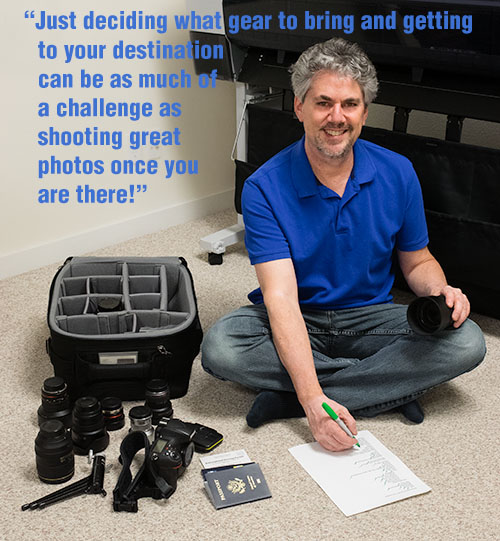
Article and photos by Joel Wolfson
When you go on a major trip with photography in mind, just deciding what gear to bring and getting to your destination and back with all of it can be as much of a challenge as shooting great photos once you are there! Over the years I’ve done a number of travel photography presentations and received a lot of good questions. Here are answers to some of the most practical questions I’ve received about the strategies of traveling for photography.
What to Bring and Using Checklists
What gear should I take with me? And…If you had to choose just one lens, what would it be?
The short answer is to travel as light as possible. My strategy is to take the minimum gear I think I will need in a case I take on the plane with me. I can fit everything I need for a long trip in my ThinkTank Airstream case which will fit overhead or under the seat, even on many small commuter planes.
The premise is that I will choose a portion of that gear to take with me when I head out each day. I have several different setups I use but I always have a camera with me. On the overseas workshops I conduct, we always have a driver with the vehicle so it is possible to take an array of gear with you and just use what you need at each stop that day and leave the rest in the van with the driver. If you don’t have that luxury or don’t feel leaving gear in your car will be safe then just take what you are willing to carry on your person. Here are examples of my kits. Naturally you want to tailor these to your own needs.
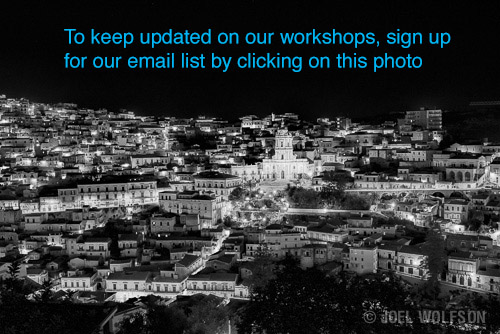
1. When I want to have maximum coverage of situations (see next section for links to gear lists with specs):
• DSLR body with walkabout lens such as 24-120 f4.0 zoom (24-105 or even 24-70 is fine too- just depends on the brand of camera and lenses available. Currently I use the Nikon D800E)
• 70-300 f4.0-5.6 zoom for telephoto needs (when I use my D800E on DX mode this range extends to 450mm)
• 18-35 f3.5-4.5 wide angle zoom for ultra wide needs (on some occasions I might bring my 14mm f2.8 if I think I will really need it)
• Travel tripod (I use a Gitzo Traveler which is a compact fold-up carbon fiber tripod because it is both lightweight and sturdy- downside is they are expensive)
• Bag, case, or sling pack: Most of this gear fits in a small shoulder bag but the tripod requires a separate case or to be strapped to the shoulder bag. Alternatively if I want to carry everything in one pack and might be out all day walking with my gear I’ll use my Kata 3N1-20 sling pack which has a tripod holder on it and compartment for some water, raincoat, protein bars, and a hat.
2. My favorite lightweight rigs, two of which include “that one lens”:
a. DSLR with a 28-300 f3.5-5.6 zoom (great for street shooting and will cover almost any situation) OR
b. ILC (Interchangeable Lens Compact- currently I use an Olympus OM-D E-M1) with 14-140mm (28-280mm equivalent) lens. I use a system called Micro 4/3 that has a vast array of camera bodies and lenses available and is lightweight and small. OR
c. ILC with (equivalent:) 24-80mm 2.8, 90-400mm f4-5.6, 14-28mm f4.0 Because my ILC system is so compact and light, all of this fits in to a very small shoulder bag.
3. Bare minimum options:
a. DSLR body with walkabout zoom such as 24-120mm f4.0 OR
b. ILC body with walkabout zoom such as 24-80mm 2.8 OR
c. iPhone. I’m not kidding. The images can’t be enlarged much and the quality is so-so but there are tons of great apps for creative use of this ultra compact camera that we almost always have with us (or equivalent if you have another smartphone). Because I always have my iPhone with me I will sometimes shoot first on my pro cameras and then do another version on the iPhone to make it easy to send in a message or quickly post online. Although some of my cameras allow me to transfer images wirelessly it is sometimes still faster to just shoot a variation on my iPhone.
**New: Recommended photography gear for traveling by brand/system**
Canon Full Frame lenses, bodies, accessories for travel
Canon APS-C (smaller sensor) lenses, bodies, accessories for travel
Nikon Full Frame (FX) lenses, bodies, accessories for travel
Nikon DX (smaller sensor) lenses, bodies, accessories for travel
Micro 4/3 mirrorless lenses, bodies, accessories for travel
Tripods and accessories for travel (scroll down to “GEAR”)
Compact/pocketable cameras with pro level quality images
Comprehensive list- just check the boxes on the left to filter your choices
Do you use checklists?
Absolutely yes. I am a huge fan of checklists and consider them essential. For travel I have checklists for camera gear, my non-camera items that I need to pack such as clothing, and travel essentials that I carry with me like passport, important phone numbers, etc., and another list for all the things I need to do prior to my trip such as get travel insurance, automatic bill paying, research which of my credit cards have best foreign exchange rates and fees, etc. I keep them on my computer and update them before every trip.
**Expanded Section** (another expanded section below about model and property releases)
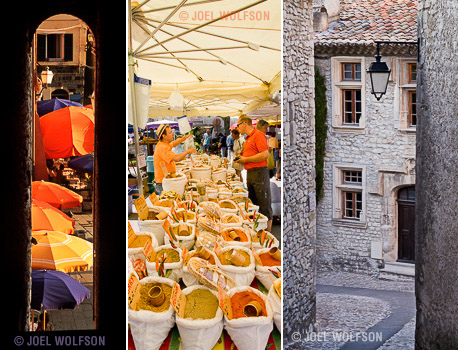
OK, so here’s the list of all the gear I pack and take with me on an out-of-town shooting trip. Remember that what I actually take with me to shoot on a given day would be one of the kits I mention above. The rest stays at the hotel or sometimes in the trunk of my rental car. If I am conducting a workshop where I have a driver then I may leave gear with him/her in the van.
Camera Gear packed in ThinkTank Airstream carry-on:
- DSLR body (currently Nikon D800E)
- 14mm f2.8
- 18-35mm f3.5-4.5
- 24-120mm f4.0
- 70-300mm f4.0-5.6
- 85mm f1.8
- Micro 4/3 body (Olympus OM-D E-M1 or Panasonic GH-3)
- 7.5mm, 20mm, 45mm primes (multiply X2 for full frame equivalent)
- 7-14mm f4.0 (14-28mm equiv)
- 12-40mm f2.8 (24-80mm equiv)
- 45-200 f4.0-5.6 (90-400mm equiv)
- spare batteries (DSLR, ILC, P&S)
- battery chargers (DSLR, ILC, P&S)
- allen wrench(es)
- data logger
- ColorChecker Passport
- polarizer, grad ND filters
- Giotto blower
- cable switches (DSLR, ILC, P&S)
- body, lens caps
- cards, card wallet
- tabletop tripod
- compass
- releases (English, Italian, French, Spanish)
Other gear packed in checked bag:
- Tripod
- Shoulder bag and/or Kiboko sling pack
- Collapsible reflector/diffuser
Do you use prime lenses?
Yes, when I can. In many ways it is subject and time dependent. If I’m street shooting and my subjects are primarily people that means I’m mostly using the central portion of the lens which is the sweet spot so a zoom will still yield great quality. Also I never know what focal length I’ll need so a zoom helps prevent losing shots while I’m changing lenses. Conversely for shooting landscapes I generally have the time to move around for the best vantage point and generally want everything sharp to the corners of the image so if I have the right prime with me I’ll use it.
Years ago I used to shoot almost exclusively primes because there was a big difference between the quality of primes and zooms. Primes are still better quality than zooms. However zooms have improved a lot. I test my lenses so I know the weak points and try to shoot around those. For traveling zooms are certainly far more convenient.
All this said the primes I generally bring with me are for my Micro 4/3 system because they are tiny and weigh practically nothing yet have stunning quality. In fact are better quality overall than Nikon or Canon lenses. For my DSLR I tend to bring a few zooms and forgo primes to save weight and space.
Packing and Flying With Your Gear
Should I check my gear or carry it on board?
I don’t ever recommend putting cameras, lenses or other gear in your checked bags. The only possible exception is a tripod. Although TSA allows you to carry on a tripod I generally pack my tripod in my checked bag because security agents sometimes get a little freaked out by them and if my bag were delayed or lost I could get by with the compact/tabletop tripod I pack in my carry-on case. If I am going to a be in a remote location where I am not likely to find a replacement tripod then I may find a way to carry it on.
Do you have any tips for packing gear?
My rule of thumb is to carry on the plane with me any gear that can’t be easily replaced at my destination in case my checked luggage is delayed or lost. This means all cameras and lenses. Although you might consider things like your camera batteries and chargers extra weight they can be the hardest things to replace, depending where you are traveling. Find a way to fit them in your carry-on bag. Make sure your transport/carry-on camera case meets the latest airline size requirements.
What concerns are there with foreign airlines?
On many of my trips I have to fly foreign airlines which means totally different security and carry-on requirements. This can happen even if you’ve booked your tickets through a U.S. Airline because they have a foreign partner and you check in on your return from a foreign country. It is common to have weight restrictions that are impossible to adhere to with camera gear such as the 5 kilo (11 lbs) carry-on limit I’ve encountered in Europe. Some don’t have an option to pay extra for the excess weight and force you to check that expensive fragile gear that will ultimately be tossed around by the baggage gorillas or maybe even stolen.
My solution? I take a camera vest with me and put it on before I walk up to the check-in counter. I put lenses and other gear in the myriad of large pockets on the vest to bring my carry-on bag down to the weight limit. I make sure I have checked all the size and weight restrictions before I leave the U.S. including weighing my bags with a scale so I know exactly what gear to put in my vest. I put the bulkiest stuff in pockets of the vest that aren’t readily visible to the check-in agent just to be on the safe side. Once the agent has checked you in and weighed your carry-on bag you can often just repack your carry-on (out of view of the ticket counter) and before you go through security. If you think your bag might get weighed again at security then you can just keep the vest on. They will of course ask you to take it off at security and at that point you can carefully put the vest in a security tray to go through the x-ray and repack your carry-on bag later.
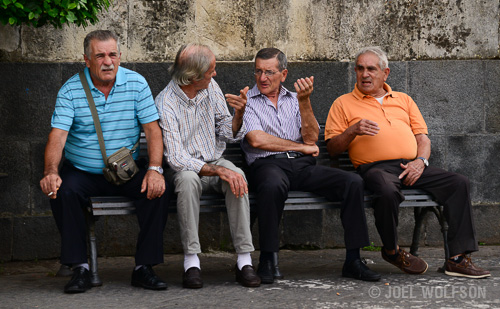
Once You Are There
Do you speak (insert language here)?
Although being proficient in the native language of the country to which you are traveling would certainly come in handy, it’s not a necessity. But what is a necessity is to learn at least a few basic phrases, be respectful and smile. As a minimum learn how to say things like “hello”, “please”, “thank you”, and “sorry I don’t speak XXXXX, do you speak english?” in the native language of the countries you visit. You’ll find that just by using a few words people are much more amenable to helping you or having their picture taken. One of the most useful phrases is simply “May I?” By pointing to your camera and saying “Posso?” in Italy or “Puis-je?” in France (you get the idea) you are able to ask permission to shoot a photo of someone or their home or shop, etc. In some countries it may also help keep you out of trouble. Using this phrase in Italy I learned that one is not allowed to shoot photos of the police. In some cases they let me shoot photos of them anyway. Either way the locals appreciate being asked, as you or I would.
Do you do backups when you are traveling?
Yes. Here is my shooting workflow: When I get back to my hotel I download all my photos to my computer (I use a Macbook Air for traveling which is very small and light). Then I back everything up to a portable external drive. Now I have two copies of each image- one set on my laptop’s main drive and one set on my external drive.
Now, as an extra precaution I copy yet another backup set to a high capacity SD card. I then mail the SD card back to my studio. This last step is for less likely but not impossible scenarios: Such as laptop and external drive being stolen from the hotel or during travel or one of those items being stolen and the other drive fails or becomes corrupted. Another important precaution, especially if you only make one backup, is to keep your laptop and backups in separate places to decrease the likelihood of both being stolen. If you are traveling with someone, have them carry the backup.
There are many other scenarios for backups: You can bring double the number of cards for your camera and simply not reuse them (you still want to download them to your laptop, tablet or phone.) Some cameras have wireless transmission and you can send copies to your phone or tablet though this is a bit cumbersome. If you have enough storage in the cloud you can back up that way too- just allow enough time, like overnight to do it. Remember that some of these scenarios require wi-fi or cell signal which you may or may not have depending upon where you travel and stay. If you are traveling to remote locations that may not have electricity you can use a battery powered backup drive to download camera cards without a computer.
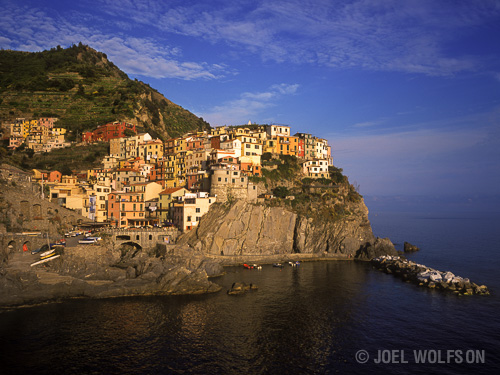
**Expanded Section**
Do you use model and property releases?
Yes, but only if I believe I will use the photos for commercial purposes. A lot of the people photos I do are really just for fine art and I won’t ever sell them for commercial purposes. If I shoot photos that include a person’s home or shop and think I might ever use those for commercial purposes or just to be on the safe side, I will ask the owners to sign a release. The only situation where it’s even feasible to get a model release for people shots is when the person being photographed is aware of it and given you their verbal permission. If I think I might need it then I’ll ask them to sign one. I keep the forms in my camera bag and I have them in several languages. I think it’s best to use very simple forms (so don’t ask a lawyer to make one for you.) If it’s too long, complicated or otherwise intimidating people won’t want to sign it. I’ve never had anyone refuse to sign one and I believe that’s because I keep it simple.
Before posting/publishing your images: Edit, edit, edit.
The key to successful presentation of your images when you return and/or posting them during your trip is to remember that less is more. Only show your very best images and be your own worst critic. It’s tempting to show others every place you went and everything you did. If you can distill it down to a handful of great images that give a feel for the greatest experiences, you’ll leave your audience wanting more rather than yawning.
Naturally there are more things to consider and these questions are about practical (non-shooting) aspects of traveling with photography as a primary goal. Hope this helps you get a head start!
See my next 2 articles on the shooting aspects of travel photography:
A Pro’s Secrets: How to Capture Stunning Travel Photos
Watch for my next article and blog posts with some of my favorite tips and tricks for capturing your own outstanding travel photos.

Excellent article, thank you!
Do you have a favorite camera vest that you could recommend?
Glad you enjoyed the article. My favorite vest is the Domke PhoTOGS. However it was recently discontinued. You can still find them online if you do a search. If not there are other brands out there. I just found the Domke to be the best for the money. Good luck! -Joel
Thanks Joel!